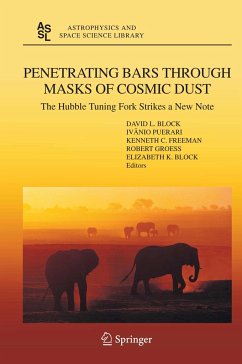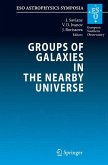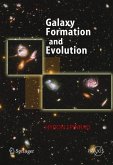Penetrating Bars through Masks of Cosmic Dust
The Hubble Tuning Fork strikes a New Note
Herausgegeben:Block, David L.; Puerari, Ivânio; Freeman, K. C.; Groess, R.; Block, Elizabeth K.
Penetrating Bars through Masks of Cosmic Dust
The Hubble Tuning Fork strikes a New Note
Herausgegeben:Block, David L.; Puerari, Ivânio; Freeman, K. C.; Groess, R.; Block, Elizabeth K.
- Gebundenes Buch
- Merkliste
- Auf die Merkliste
- Bewerten Bewerten
- Teilen
- Produkt teilen
- Produkterinnerung
- Produkterinnerung
THE EDITORS: DAVID L. BLOCK AND KENNETH C. FREEMAN (SOC CO-CHAIRS), IVANIO PUERARI, ROBERT GROESS AND LIZ K. BLOCK 1. Harvard College Observatory, 1958 The past century has truly brought about an explosive period of growth and discovery for the physical sciences as a whole, and for astronomy in particular. Galaxy morphology has reached a renaissance . . The year: 1958. The date: October 1. The venue: Harvard College Observatory. The lecturer: Walter Baade. With amazing foresight, Baade penned these words: "Young stars, supergiants and so on, make a terrific splash - lots of light. The total…mehr
![Groups of Galaxies in the Nearby Universe Groups of Galaxies in the Nearby Universe]() Ivo Saviane / Valentin D. Ivanov / Jordanka Borissova (eds.)Groups of Galaxies in the Nearby Universe37,99 €
Ivo Saviane / Valentin D. Ivanov / Jordanka Borissova (eds.)Groups of Galaxies in the Nearby Universe37,99 €![Starbursts Starbursts]() Richard de Grijs / Rosa M. González Delgado (eds.)Starbursts154,99 €
Richard de Grijs / Rosa M. González Delgado (eds.)Starbursts154,99 €![Galaxy Formation and Evolution Galaxy Formation and Evolution]() Hyron SpinradGalaxy Formation and Evolution74,99 €
Hyron SpinradGalaxy Formation and Evolution74,99 €![Galaxy Formation and Evolution Galaxy Formation and Evolution]() Hyron SpinradGalaxy Formation and Evolution77,99 €
Hyron SpinradGalaxy Formation and Evolution77,99 €![The Dense Interstellar Medium in Galaxies The Dense Interstellar Medium in Galaxies]() Susanne Pfalzner / Carsten Kramer / Christian Straubmeier / Andreas Heithausen (eds.)The Dense Interstellar Medium in Galaxies154,99 €
Susanne Pfalzner / Carsten Kramer / Christian Straubmeier / Andreas Heithausen (eds.)The Dense Interstellar Medium in Galaxies154,99 €![Island Universes Island Universes]() R. S. de JongIsland Universes147,99 €
R. S. de JongIsland Universes147,99 €![Soft X-Ray Emission from Clusters of Galaxies and Related Phenomena Soft X-Ray Emission from Clusters of Galaxies and Related Phenomena]() Richard Lieu / Jonathan Mittaz (Hgg.)Soft X-Ray Emission from Clusters of Galaxies and Related Phenomena74,99 €
Richard Lieu / Jonathan Mittaz (Hgg.)Soft X-Ray Emission from Clusters of Galaxies and Related Phenomena74,99 €-
-
-
- Produktdetails
- Astrophysics and Space Science Library 319
- Verlag: Springer / Springer Netherlands
- Artikelnr. des Verlages: 978-1-4020-2861-8
- 2004
- Seitenzahl: 908
- Erscheinungstermin: 29. November 2004
- Englisch
- Abmessung: 241mm x 160mm x 54mm
- Gewicht: 1507g
- ISBN-13: 9781402028618
- ISBN-10: 140202861X
- Artikelnr.: 13741786
- Astrophysics and Space Science Library 319
- Verlag: Springer / Springer Netherlands
- Artikelnr. des Verlages: 978-1-4020-2861-8
- 2004
- Seitenzahl: 908
- Erscheinungstermin: 29. November 2004
- Englisch
- Abmessung: 241mm x 160mm x 54mm
- Gewicht: 1507g
- ISBN-13: 9781402028618
- ISBN-10: 140202861X
- Artikelnr.: 13741786
The Editors - Preface.- A Tribute to Cosmic Dust Pioneer J. Mayo Greenberg.- The Hubble Tuning Fork Strikes a New Note.- Episodes in the Development of the Hubble Galaxy Classification.- Secular Evolution Versus Hierarchical Merging: Galaxy Evolution along the Hubble-sequence, in the Fields and Rich Environments.- Dense Gas and Star Formation in Bars.- On the Origin of S0 Galaxies.- Gravitational Bar Torques in the Spiral/S0 Divide.- Direct Measurement of Pattern Speeds In Double-Barred SB0s.- Gas Flows, Star Formation and Galaxy Evolution.- Bar-Driven Evolution and 2D Spectroscopy of Bulges.- Bar-Driven Fueling of Galactic Nuclei: a 2D view.- Dust Penetrated Arm Classes: Insight form Rising and Falling RotationCurves.- Bar Dissolution and Reformation Mechanisms.- Dynamics of Doubly Barred Galaxies, also with the Inner Bar Retrograde.- A Coordinated Episode of AGB Star Production at Large Galactocentric Distances in the Andromeda Galaxy.- Fuelling Starbursts and AGN.- Penetrating Dust Tori in AGN.- Bars from the Inside Out: An HST Study of their Dusty Circumnuclear Regions.- Morphology of Bar and Spiral Modes: do they relate?- Bar Formation by Galaxy-Galaxy Interactions.- Triggering AGNs - Interactions or Bars?- Triggered Star Formation: from Large to Small Scales.- Investigation of Age and Metallicity Gradients in Spiral Galaxies.- Secular Evolution and the Growth of Pseudobulges in Disk Galaxies.- Bars and Lences in Spiral Galaxies: Clues for Secular Evolution.- Evolution and Impact of Bars over the last nine Gyr: Early Results from GEMS.- First Phylogenetic Analysis of Galaxy Evolution.- A Unified Picture of Disk Galaxies where Bars, Spirals and Warps Result from the Same Fundamental Causes.- On the Generation of the Hubble Sequence trough an Internal Secular Dynamical Process.- The Angular Momentum Problem and the Formation of Bulgeless Galaxies.- Disks Evolution in a Cosmological Framework.- Galaxy Formation and the Cosmological Angular Momentum Problem.- The Problems with Galaxy Formation.- The Interplay between Bars and Dark Matter Halos.- Resent Results from the Spitzer Space Telescope: A New View of Galaxy Morphology and Classification.- Using Bars as Signposts of Galaxy Evolution at High and Low Redshifts.- The VIMOS VLT Deep Survey: Redshift Distribution of a IAB > 24 Sample, and the Effect of Environment on Galaxy Evolution.- An HST AOS/WFC Ha Imaging Survey of Nearby Galaxies.- HST Mid-UV Imaging of Nearby Galaxies.- Bulges, Disks and Kinematics of Galaxies at z ~ 1.- Fourier Decomposition of Galaxies.- The Evolutionary Status of Clusters of Galaxies at z ~ 1.- Distant z>2 Protoclusters and their Galaxies.- The Galaxy Structure - Redshift Relationship.- The Cosmic Background: Evolution of Infrared Galaxies and Dust Properties.- A lecture Dedicated to the Memory of Mayo Greenberg.- The Physical Evolution of Mass and Dust in Distant Galaxies.- The Warm, Cold and Very Cold Dusty Universe A.- Li Turbulence and Galactic Structure.- Chaos in Spiral Galaxies.- Obtaining Statistics of Turbulent Velocity from Astrophysical Spectral Line Data.- Estimating Power Spectra of Galaxy Structure: Can Statistics Help?- From z>6 to z~2: Unearthing Galaxies at the Edge of the Dark Ages.- Masks in the Milky Way.- The Hierarchical Formation of the Galactic Disk.- The SINGS view of Barred Galaxies.- Quantifying Bar Strength: Morphology Meets Methodology.- Estimation of Bar Strengths from nearby IR Images.- Bar Strengths Measured for the OSUBGS sample: active vs non-active galaxies.- Globular Clusters: Galactic and Internal Motions.- Evolution of Self-Gravitating Gas Disks Driven by a Rotating Bar Potential.- Stellar Disk Truncations: Where do we stand?- On the unification of Dwarf and Giant Elliptical Galaxies.- Photodissociation and the morphology of HI in Galaxies.- The True H2 Content of Spiral Galaxies.- X-Ray Perspective of Early Type Galaxies.- Spiral Arm Star Formation in Barred Galaxies.- Galaxy Types and Luminosity Functions in the Soan Digital Sky Survey using Artificial Neural Networks.- Globular Cluster Systems and Supermassive Galactic Black Holes.- Pseudobulges in Barred S0 Galaxies.- Bar and Spiral Torques in the Triangulum Galaxy M33.- Bar Parameters from Ha Observations Molecular Gas in Classical Elliptical Radio Galaxies.- Bars and Dust Multi Wavelength Maps of Simulations of Galaxy Formation.- How Barred is the NIR Nearby Universe? An Analysis using 2MASS.- Truncation of Stellar Disks at high Redshift Is there a Large Stellar Bar in the LSB Galaxy UGC7321? Spiral structure of the Milky Way: The state of Affairs.- Uncovering Morphology from dust: a NIR View of the Interacting Galaxy Pair NGC5394/95.- SCUBA Local Universe Galaxy Survey.- How JWST can measure First Light, Reionization and Galaxy Assembly.- High Resolution Velocity Fields in the Strongly Barred Galaxy NGC 1530.- Panel Discussion -Closing Conference Thoughts.-The Noblest Scientific Problem of the Age: Perspectives on the Transit of Venus, 1882 and 2004 Description of the Commemorative Medallion, Struck to Celebrate the Transition of Venus, Observed from South Africa on 8 June 2004.- Caption for Colour plates.- The 16 colour plates.- List of Participants.
The Editors - Preface.- A Tribute to Cosmic Dust Pioneer J. Mayo Greenberg.- The Hubble Tuning Fork Strikes a New Note.- Episodes in the Development of the Hubble Galaxy Classification.- Secular Evolution Versus Hierarchical Merging: Galaxy Evolution along the Hubble-sequence, in the Fields and Rich Environments.- Dense Gas and Star Formation in Bars.- On the Origin of S0 Galaxies.- Gravitational Bar Torques in the Spiral/S0 Divide.- Direct Measurement of Pattern Speeds In Double-Barred SB0s.- Gas Flows, Star Formation and Galaxy Evolution.- Bar-Driven Evolution and 2D Spectroscopy of Bulges.- Bar-Driven Fueling of Galactic Nuclei: a 2D view.- Dust Penetrated Arm Classes: Insight form Rising and Falling RotationCurves.- Bar Dissolution and Reformation Mechanisms.- Dynamics of Doubly Barred Galaxies, also with the Inner Bar Retrograde.- A Coordinated Episode of AGB Star Production at Large Galactocentric Distances in the Andromeda Galaxy.- Fuelling Starbursts and AGN.- Penetrating Dust Tori in AGN.- Bars from the Inside Out: An HST Study of their Dusty Circumnuclear Regions.- Morphology of Bar and Spiral Modes: do they relate?- Bar Formation by Galaxy-Galaxy Interactions.- Triggering AGNs - Interactions or Bars?- Triggered Star Formation: from Large to Small Scales.- Investigation of Age and Metallicity Gradients in Spiral Galaxies.- Secular Evolution and the Growth of Pseudobulges in Disk Galaxies.- Bars and Lences in Spiral Galaxies: Clues for Secular Evolution.- Evolution and Impact of Bars over the last nine Gyr: Early Results from GEMS.- First Phylogenetic Analysis of Galaxy Evolution.- A Unified Picture of Disk Galaxies where Bars, Spirals and Warps Result from the Same Fundamental Causes.- On the Generation of the Hubble Sequence trough an Internal Secular Dynamical Process.- The Angular Momentum Problem and the Formation of Bulgeless Galaxies.- Disks Evolution in a Cosmological Framework.- Galaxy Formation and the Cosmological Angular Momentum Problem.- The Problems with Galaxy Formation.- The Interplay between Bars and Dark Matter Halos.- Resent Results from the Spitzer Space Telescope: A New View of Galaxy Morphology and Classification.- Using Bars as Signposts of Galaxy Evolution at High and Low Redshifts.- The VIMOS VLT Deep Survey: Redshift Distribution of a IAB > 24 Sample, and the Effect of Environment on Galaxy Evolution.- An HST AOS/WFC Ha Imaging Survey of Nearby Galaxies.- HST Mid-UV Imaging of Nearby Galaxies.- Bulges, Disks and Kinematics of Galaxies at z ~ 1.- Fourier Decomposition of Galaxies.- The Evolutionary Status of Clusters of Galaxies at z ~ 1.- Distant z>2 Protoclusters and their Galaxies.- The Galaxy Structure - Redshift Relationship.- The Cosmic Background: Evolution of Infrared Galaxies and Dust Properties.- A lecture Dedicated to the Memory of Mayo Greenberg.- The Physical Evolution of Mass and Dust in Distant Galaxies.- The Warm, Cold and Very Cold Dusty Universe A.- Li Turbulence and Galactic Structure.- Chaos in Spiral Galaxies.- Obtaining Statistics of Turbulent Velocity from Astrophysical Spectral Line Data.- Estimating Power Spectra of Galaxy Structure: Can Statistics Help?- From z>6 to z~2: Unearthing Galaxies at the Edge of the Dark Ages.- Masks in the Milky Way.- The Hierarchical Formation of the Galactic Disk.- The SINGS view of Barred Galaxies.- Quantifying Bar Strength: Morphology Meets Methodology.- Estimation of Bar Strengths from nearby IR Images.- Bar Strengths Measured for the OSUBGS sample: active vs non-active galaxies.- Globular Clusters: Galactic and Internal Motions.- Evolution of Self-Gravitating Gas Disks Driven by a Rotating Bar Potential.- Stellar Disk Truncations: Where do we stand?- On the unification of Dwarf and Giant Elliptical Galaxies.- Photodissociation and the morphology of HI in Galaxies.- The True H2 Content of Spiral Galaxies.- X-Ray Perspective of Early Type Galaxies.- Spiral Arm Star Formation in Barred Galaxies.- Galaxy Types and Luminosity Functions in the Soan Digital Sky Survey using Artificial Neural Networks.- Globular Cluster Systems and Supermassive Galactic Black Holes.- Pseudobulges in Barred S0 Galaxies.- Bar and Spiral Torques in the Triangulum Galaxy M33.- Bar Parameters from Ha Observations Molecular Gas in Classical Elliptical Radio Galaxies.- Bars and Dust Multi Wavelength Maps of Simulations of Galaxy Formation.- How Barred is the NIR Nearby Universe? An Analysis using 2MASS.- Truncation of Stellar Disks at high Redshift Is there a Large Stellar Bar in the LSB Galaxy UGC7321? Spiral structure of the Milky Way: The state of Affairs.- Uncovering Morphology from dust: a NIR View of the Interacting Galaxy Pair NGC5394/95.- SCUBA Local Universe Galaxy Survey.- How JWST can measure First Light, Reionization and Galaxy Assembly.- High Resolution Velocity Fields in the Strongly Barred Galaxy NGC 1530.- Panel Discussion -Closing Conference Thoughts.-The Noblest Scientific Problem of the Age: Perspectives on the Transit of Venus, 1882 and 2004 Description of the Commemorative Medallion, Struck to Celebrate the Transition of Venus, Observed from South Africa on 8 June 2004.- Caption for Colour plates.- The 16 colour plates.- List of Participants.








